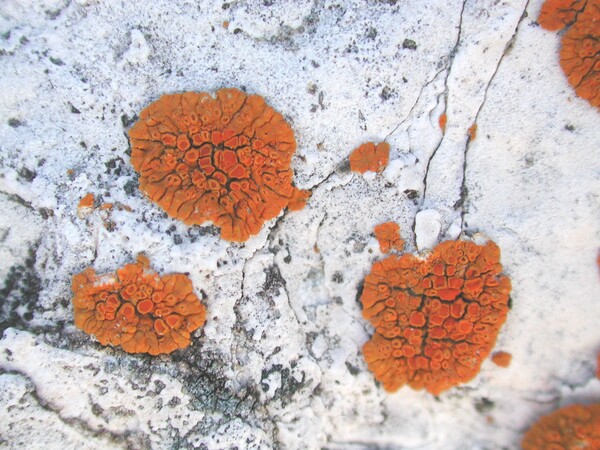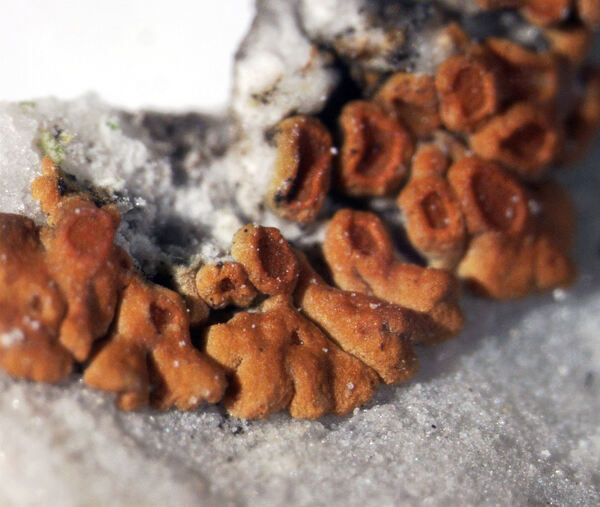Calogaya miniata (Hoffm.) Wilk & Lücking
Mycotaxon, 136, 2: 393, 2021. Basionym: Psora miniata Hoffm. - Enum. Lich.: 63, 1784
Synonyms: Amphiloma pusillum var. miniatum (Hoffm.) Bagl.; Caloplaca miniata (Hoffm.) Jatta; Caloplaca murorum f. miniata (Hoffm.) Ozenda & Clauzade; Caloplaca pusilla var. miniata (Hoffm.) Jatta; Caloplaca rouxii Gaya, Nav.-Ros. & Llimona; Gasparrinia murorum f. miniata (Hoffm.) Dalla Torre & Sarnth.; Lecanora miniata (Hoffm.) Ach.; Physcia murorum var. miniata (Hoffm.) Arnold; Physcia pusilla var. miniata (Hoffm.) Arnold; Placodium pusillum var. miniatum (Hoffm.) Anzi
Description: Thallus crustose-placodioid, episubstratic, rather loosely attached, bright scarlet red or orange-red, epruinose, usually with discoloured patches resembling pseudocyphellae, forming orbicular, up to 1.2 cm wide rosettes. Marginal lobes up to 1.2 mm long, strongly convex, contiguous to overlapping; central parts of thallus of flat, angular areoles. Cortex prosoplectenchymatous, 30-80 µm thick, with hyphal cells perpendicular to the surface, and partially reaching the algal layer. Apothecia numerous, covering the base of lobes, 0.3-1.2(-1.8) mm across, at first immersed in the thallus, then adnate to broadly sessile, round to irregular in outline by mutual compression, with a concave to finally slightly convex, scarlet red to red-orange, epruinose disc, a thin, paler proper margin, and a smooth to crenulate thalline margin concolorous to thallus. Epithecium 6-14 µm thick, brownish yellow, K+ purple-red; hymenium colourless, 50-95 µm high; paraphyses richly branched, 1.5-3.5 µm thick at base, the apical cells 3-6.5 µm wide; hypothecium colourless. Asci 8-spored, clavate, functionally unitunicate, apically thickened with a broad internal beak, the inner part of apex and external cap I+ blue, Teloschistes-type. Ascospores 2-celled, polarilocular, hyaline, narrowly ellipsoid, (10-)11.5-15(16.5) x (3.5-)5-6(-7), the equatorial thickening (“septum”) (2.5-)3.5-5(-6) µm. Photobiont chlorococcoid. Spot tests: thallus and apothecia K+ purple-red, C-, KC-, P-. Chemistry: thallus and apothecia with unidentified anthraquinones.
Growth form: Crustose
Substrata: rocks
Photobiont: green algae other than Trentepohlia
Reproductive strategy: mainly sexual
Commonnes-rarity: (info)
Alpine belt: rather common
Subalpine belt: rather rare
Montane belt: very rare
Dry submediterranean belt: absent
Humid submediterranean belt: absent
Padanian area: absent
pH of the substrata:
1 2 3 4 5
Solar irradiation:
1 2 3 4 5
Aridity:
1 2 3 4 5
Eutrophication:
1 2 3 4 5
Poleotolerance:
0 1 2 3
Altitudinal distribution:
1 2 3 4 5 6
Rarity
absent
extremely rare
very rare
rare
rather rare
rather common
common
very common
extremely common
Loading data...
Occurrence data
Predictive map
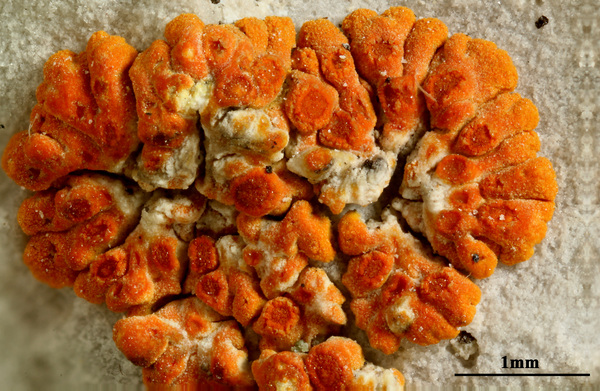
Felix Schumm - CC BY-SA 4.0
[19567], Austria, Styria, Hochschwab montium Alpium, in monte Griesmauer, alt. 1750 m, in rupibus calcareis. Leg. J. Poelt & A. Vezda, 19.09.1982. VEZDA: LICHENES SELECTI EXSICCATI NR. 1862.

P.L. Nimis; Owner: Department of Life Sciences, University of Trieste
Herbarium: TSB (32977)
2001/12/04
As Caloplaca arnoldii
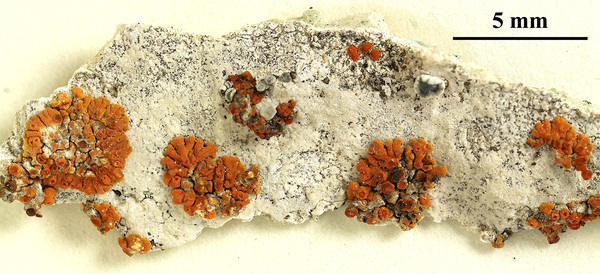
Felix Schumm - CC BY-SA 4.0
[19567], Austria, Styria, Hochschwab montium Alpium, in monte Griesmauer, alt. 1750 m, in rupibus calcareis. Leg. J. Poelt & A. Vezda, 19.09.1982. VEZDA: LICHENES SELECTI EXSICCATI NR. 1862.
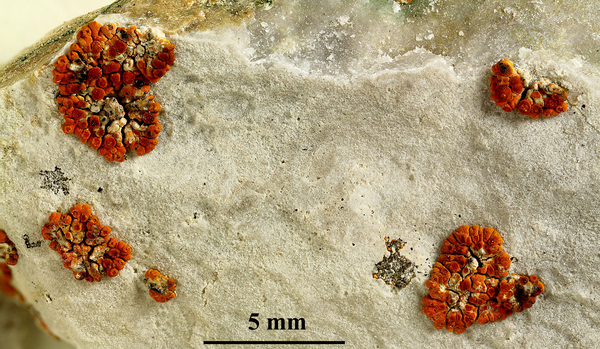
Felix Schumm - CC BY-SA 4.0
[19567], Austria, Styria, Hochschwab montium Alpium, in monte Griesmauer, alt. 1750 m, in rupibus calcareis. Leg. J. Poelt & A. Vezda, 19.09.1982. VEZDA: LICHENES SELECTI EXSICCATI NR. 1862.
AS Caloplaca arnoldii
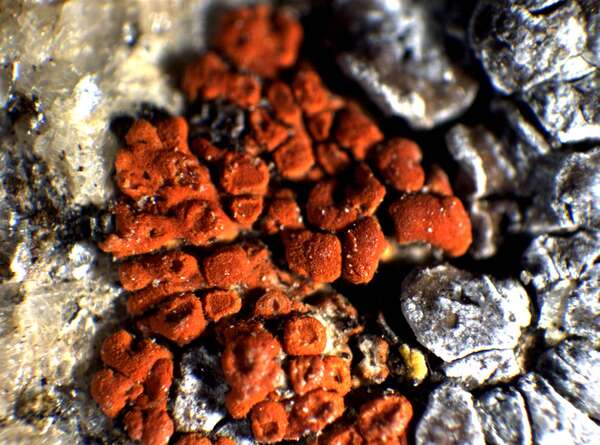
P.L. Nimis; Owner: Department of Life Sciences, University of Trieste
Herbarium: TSB (32977)
2001/11/19
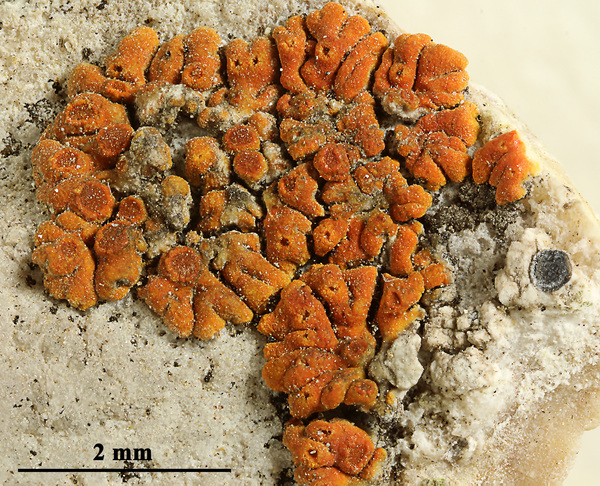
Felix Schumm - CC BY-SA 4.0
[19567], Austria, Styria, Hochschwab montium Alpium, in monte Griesmauer, alt. 1750 m, in rupibus calcareis. Leg. J. Poelt & A. Vezda, 19.09.1982. VEZDA: LICHENES SELECTI EXSICCATI NR. 1862.
AS Caloplaca arnoldii
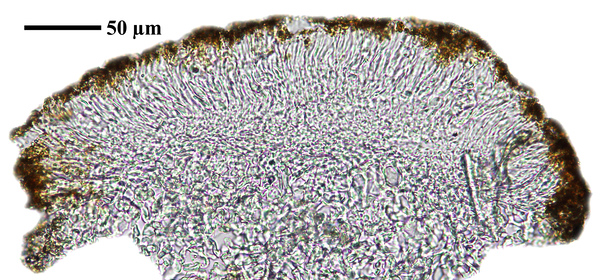
Felix Schumm; Owner: Felix Schumm - CC BY-SA 4.0
[19567], Austria, Styria, Hochschwab montium Alpium, in monte Griesmauer, alt. 1750 m, in rupibus calcareis. Leg. J. Poelt & A. Vezda, 19.09.1982. VEZDA: LICHENES SELECTI EXSICCATI NR. 1862.
AS Caloplaca arnoldii
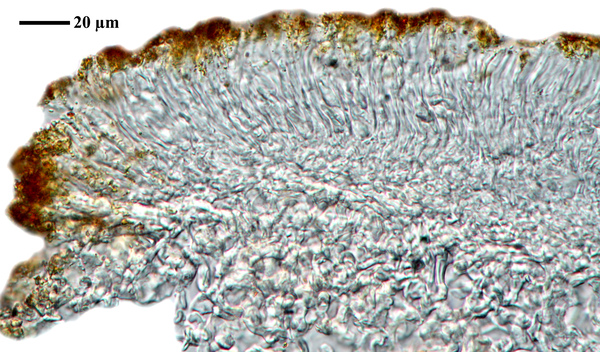
Felix Schumm; Owner: Felix Schumm - CC BY-SA 4.0
[19567], Austria, Styria, Hochschwab montium Alpium, in monte Griesmauer, alt. 1750 m, in rupibus calcareis. Leg. J. Poelt & A. Vezda, 19.09.1982. VEZDA: LICHENES SELECTI EXSICCATI NR. 1862.
AS Caloplaca arnoldii
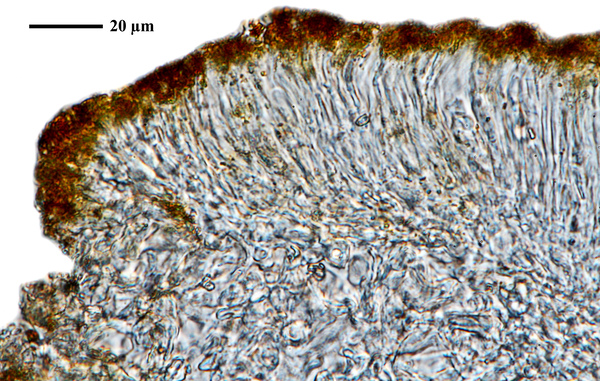
Felix Schumm; Owner: Felix Schumm - CC BY-SA 4.0
[19567], Austria, Styria, Hochschwab montium Alpium, in monte Griesmauer, alt. 1750 m, in rupibus calcareis. Leg. J. Poelt & A. Vezda, 19.09.1982. VEZDA: LICHENES SELECTI EXSICCATI NR. 1862.
AS Caloplaca arnoldii
Growth form: Crustose
Substrata: rocks
Photobiont: green algae other than Trentepohlia
Reproductive strategy: mainly sexual
Commonnes-rarity: (info)
Alpine belt: rather common
Subalpine belt: rather rare
Montane belt: very rare
Dry submediterranean belt: absent
Humid submediterranean belt: absent
Padanian area: absent
pH of the substrata:
| 1 | 2 | 3 | 4 | 5 |
Solar irradiation:
| 1 | 2 | 3 | 4 | 5 |
Aridity:
| 1 | 2 | 3 | 4 | 5 |
Eutrophication:
| 1 | 2 | 3 | 4 | 5 |
Poleotolerance:
| 0 | 1 | 2 | 3 |
Altitudinal distribution:
| 1 | 2 | 3 | 4 | 5 | 6 |
Rarity
absent
extremely rare
very rare
rare
rather rare
rather common
common
very common
extremely common
Loading data...
Occurrence data
Predictive map

Felix Schumm - CC BY-SA 4.0
[19567], Austria, Styria, Hochschwab montium Alpium, in monte Griesmauer, alt. 1750 m, in rupibus calcareis. Leg. J. Poelt & A. Vezda, 19.09.1982. VEZDA: LICHENES SELECTI EXSICCATI NR. 1862.

P.L. Nimis; Owner: Department of Life Sciences, University of Trieste
Herbarium: TSB (32977)
2001/12/04
As Caloplaca arnoldii

Felix Schumm - CC BY-SA 4.0
[19567], Austria, Styria, Hochschwab montium Alpium, in monte Griesmauer, alt. 1750 m, in rupibus calcareis. Leg. J. Poelt & A. Vezda, 19.09.1982. VEZDA: LICHENES SELECTI EXSICCATI NR. 1862.

Felix Schumm - CC BY-SA 4.0
[19567], Austria, Styria, Hochschwab montium Alpium, in monte Griesmauer, alt. 1750 m, in rupibus calcareis. Leg. J. Poelt & A. Vezda, 19.09.1982. VEZDA: LICHENES SELECTI EXSICCATI NR. 1862.
AS Caloplaca arnoldii

P.L. Nimis; Owner: Department of Life Sciences, University of Trieste
Herbarium: TSB (32977)
2001/11/19

Felix Schumm - CC BY-SA 4.0
[19567], Austria, Styria, Hochschwab montium Alpium, in monte Griesmauer, alt. 1750 m, in rupibus calcareis. Leg. J. Poelt & A. Vezda, 19.09.1982. VEZDA: LICHENES SELECTI EXSICCATI NR. 1862.
AS Caloplaca arnoldii

Felix Schumm; Owner: Felix Schumm - CC BY-SA 4.0
[19567], Austria, Styria, Hochschwab montium Alpium, in monte Griesmauer, alt. 1750 m, in rupibus calcareis. Leg. J. Poelt & A. Vezda, 19.09.1982. VEZDA: LICHENES SELECTI EXSICCATI NR. 1862.
AS Caloplaca arnoldii

Felix Schumm; Owner: Felix Schumm - CC BY-SA 4.0
[19567], Austria, Styria, Hochschwab montium Alpium, in monte Griesmauer, alt. 1750 m, in rupibus calcareis. Leg. J. Poelt & A. Vezda, 19.09.1982. VEZDA: LICHENES SELECTI EXSICCATI NR. 1862.
AS Caloplaca arnoldii



